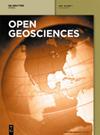中国中部渭河断层的构造特征和构造活动
IF 1.3
4区 地球科学
Q3 GEOSCIENCES, MULTIDISCIPLINARY
引用次数: 0
摘要
构造活动研究对于评估历史和现代地震风险具有重要意义。渭河地堑是中国一个重要的大陆内地堑系统,有许多活动断层,曾引发一系列地震,包括 1556 年的华县大地震(M ∼ 8.5),造成约 83 万人死亡。尽管渭河断层与这些地震之间存在明显的空间关系,但对该断层的详细研究仍然缺乏。我们利用遥感图像、数字高程模型、浅层地震测线、沟槽挖掘、钻探剖面和光激发发光测年等多种技术,得出了以下结果:(1)渭河断层穿过咸阳北部渭河阶地的陡崖,在金家村可分为东西两段;(2)渭河断层为正断层,走向东北,倾角65°-75°,倾角南倾;(3)该断层在全新世期间一直处于活动状态;(4)垂直偏移和测年结果表明,自更新世晚期以来,断层活动逐渐减弱,全新世期间的垂直滑动速率仅为0.04-0.13毫米/年。04-0.13 毫米/年。本文章由计算机程序翻译,如有差异,请以英文原文为准。
Structural features and tectonic activity of the Weihe Fault, central China
The study of tectonic activity holds great significance in assessing historical and modern seismic risks. The Weihe Graben is a significant intracontinental graben system in China, with numerous active faults that have caused a series of earthquakes, including the Huaxian great earthquake (M ∼ 8.5) in 1556 with approximately 830,000 deaths. Despite the obvious spatial relationship between the Weihe fault (WF) and these earthquakes, detailed research on the fault is still lacking. Various techniques including remote sensing images, digital elevation model, shallow seismic lines, trench excavation, drilling sections, and optically stimulated luminescence dating, have been utilized to obtain the following results: (1) The WF passes through the scarp of the Weihe River terrace in the north of Xianyang and can be divided into east and west sections at Jinjia village; (2) The WF is a normal fault that strikes northeast and dips south with a dipping angle of 65°–75°; (3) The fault has been active during the Holocene; (4) The vertically offset and dating results suggest that the fault activity has gradually decreased since the late Pleistocene, and the vertical slip rate during the Holocene is only 0.04–0.13 mm/year.
求助全文
通过发布文献求助,成功后即可免费获取论文全文。
去求助
来源期刊

Open Geosciences
GEOSCIENCES, MULTIDISCIPLINARY-
CiteScore
3.10
自引率
10.00%
发文量
63
审稿时长
15 weeks
期刊介绍:
Open Geosciences (formerly Central European Journal of Geosciences - CEJG) is an open access, peer-reviewed journal publishing original research results from all fields of Earth Sciences such as: Atmospheric Sciences, Geology, Geophysics, Geography, Oceanography and Hydrology, Glaciology, Speleology, Volcanology, Soil Science, Palaeoecology, Geotourism, Geoinformatics, Geostatistics.
 求助内容:
求助内容: 应助结果提醒方式:
应助结果提醒方式:


